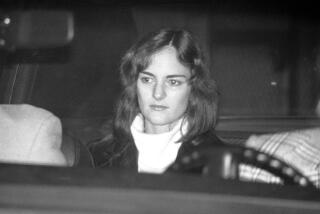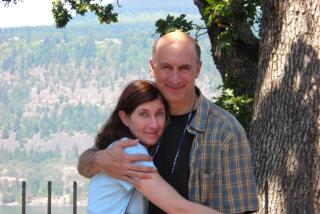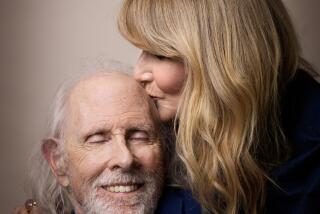Trying hard to turn the page
Second of two parts
Mike Bradbury did what he could to flee the past.
As 1990 began, he and his wife, Patty, sold their condo in Huntington Beach and moved with their two children to a small rental home in the Northern California town of Grass Valley.
They allowed few reminders of their first-born daughter. One was a bumper sticker, affixed to the back of their aged VW. It featured a photograph of her, underscored by the words Help Find Laura. They didn’t have the heart to peel the sticker off.
The Bradburys told nobody in Grass Valley what had happened to them or why they were there. But some in town recognized them anyway.
Five years earlier, during a family camping trip to Joshua Tree National Park, 31/2-year-old Laura Bradbury had followed her brother Travis, then 8, to a portable toilet and vanished. The search for her became a national story and Laura was one of the first missing children to be featured on milk cartons.
Within weeks of the disappearance, Mike and Patty created the Laura Center in Orange County, a nonprofit organization that mailed fliers and held regular news conferences.
With no real answers, the years since had been filled with anguish that seemed without end.
The San Bernardino County Sheriff’s Department had investigated Laura’s disappearance — efforts that were ongoing. But Mike had lost faith in the deputies and he’d mounted his own angry search. Along with a private investigator, he combed the isolated communities near Joshua Tree, known for attracting drug dealers and oddballs.
His hunt, too, came to nothing, and the toll on his family and marriage was staggering. Moving to Grass Valley was both an avenue to a new life for the family and a painful admission that he had done all he could.
Yet he couldn’t give up hope. Neither could Patty. She told no one — not Mike, Travis or her little girl, Emily — that she had been writing to Laura ever since she vanished.
*
Today you are nine years old… I can hardly believe it. How time is swallowed up as if it never was…I still want to search kids out to see what a nine year old looks like and try to imagine my three years (sic) old who is frozen in time…Not having you has left holes in many places. I don’t remember Emily’s babyhood – when did she walk, talk? — God, how unfair. My marriage is numb…Travis is deeply wounded…We have no home now. On that last night [in Huntington Beach] I stayed late and the memories flooded the place. I remember you with floppy and you and Travis in the sand box and you in the crib and the new big girl baby bed. Christmas, Easters — so little time and how little did I appreciate it.
— Letter from Patty to Laura, May 29, 1990
*
One afternoon during their first winter in Grass Valley, the phone rang. “Mr. Bradbury,” said a Department of Justice official, “we have some news …”
For years, he and Patty had waited for this call. They’d prayed it would solve the mystery. In 1986, four years earlier, a hiker had stumbled upon remnants of a small skull, two miles from the campsite. A San Bernardino County sheriff’s captain publicly speculated that it was Laura’s but several tests were inconclusive.
This call was about a DNA test more accurate than any done before. Mike held his breath.
“Mr. Bradbury,” the official said, “the test shows with a 99.9% certainty that the skull is your daughter’s.”
Mike looked over his shoulder and saw Patty, frozen, covering her mouth. When he hung up, she bolted to the bedroom and he followed her. That night, they held each other for hours.
Over the years, there had been credible tips from people claiming they’d seen Laura. None panned out. Each added to the emotional shield around the family, protection that allowed them to accept this latest news with grim resignation.
They wrote to the San Bernardino County coroner’s office, asking for the skull. They wanted to hold a memorial service and burial.
“We waited, we waited, we waited,” Mike says, his words and eyes sharp, as they often are when he speaks of Laura. “And when we did not get any reply … we started wondering if maybe there was something wrong with the test…. We didn’t ever pursue getting the bones back any further. From then on there would always be a question: Was it really her?
“By then, and I hated this, but Patty wanted to have us move on. She simply forbade me from dealing with this any longer.”
*
In Grass Valley, the family never found solid footing. They’d spent so much on the search for Laura that paying the bills was a struggle. Mike put together enough money to buy several vending machines, hoping to live off the profit. It wasn’t enough. Patty got a job as a veterinarian’s assistant, but that didn’t help much. At one point they moved in with new friends because they couldn’t afford a decent place to rent.
Maybe we should go back to Huntington Beach, Mike told his wife.
“You can leave,” she said. “But I won’t be going with you.” She vowed never to return to the place of such heartache.
Then there was Travis. He was deeply troubled, overwhelmed by guilt over what had happened to his sister. He struggled in school. He refused to say Laura’s name.
There was Emily, just an infant when her older sister disappeared. She had no memories from her first five years. “What I remember after that,” she says, “was that it felt like there was always a cloud over us. That — and my mom clinging to me.”
One day, when she was 6 and grocery shopping with her mother, Emily briefly became lost. By the time they were reunited, Patty was in a panic, shrieking breathlessly.
“For a long time, I even looked like Laura, and it was like my mom wanted me to be Laura,” Emily recalls. “My life was about filling every moment with things I did just for my mom, things she wanted for my sister, especially Girl Scouts, which I wasn’t into.”
Yet they could never talk about Laura. “With Mom, Laura was something we learned not to bring up,” Emily says.
Patty hid her feelings from everyone. She was always smiling, always on the go.
But by 2000, she had begun complaining of unceasing fatigue. Her wrists tingled. Her heart began beating so fast that she was hospitalized. Test showed she had bone cancer and amyloidosis, a rare disease that harms vital organs.
On Sept. 5, 2001, she lay in a room at Sierra Nevada Memorial Hospital. Mike read Bible verses to her.
“If you go to be with Jesus,” he asked, “will you watch over us?”
“Yes,” she promised. It had been a long time since she’d said anything to him about their missing girl. Now she added: “And I will be with Laura too.”
Hours later, she died.
*
“It was as if we all became zombies,” Mike Bradbury says of the years after Patty’s death. “For a long time, with all we’d gone through, we were just going through the motions of life.”
By 2009, as he turned 66, they were living in a small $600-a-month apartment in a ramshackle part of Portland. He had hoped another change of scenery would help.
Emily — who never graduated from high school and was in her mid-20s —slept in a bedroom down the hall. Travis — drinking heavily, jobless and in his early 30s — slept on the living room couch. Mike hadn’t worked in years. The family survived largely on his Social Security checks.
He thought often of his wife. After she died, he’d discovered her letters to Laura hidden in a sock drawer, inside a box that had contained blank checks. He could manage to read only a few of them. The letters stopped in 1991, but he believed Patty had kept writing to Laura in a small white diary that he’d also found. He couldn’t bring himself to open it.
Imagining the comfort she must have felt from putting her feelings on paper, he began writing down his own memories: the tragic day, the search, his suspicions, his fights with the sheriff’s deputies, his resentments and doubts.
The writing was a balm.
One morning last summer, he turned on the television. A girl named Jaycee Lee Dugard had been found 19 years after being snatched off the street. For all that time, she had been kept in the Bay Area backyard of the convicted rapist who’d kidnapped her. She’d endured unimaginable treatment. But my God, Mike thought, she was alive!
He recalled how Patty’s parents had marched in a vigil for Jaycee soon after she disappeared. They’d been quoted in newspapers: the family of one missing girl supporting the family of another. Maybe, he let himself think, Laura was trapped inside a similar nightmare.
Maybe Laura was alive.
Energized by his writing — he had turned his memories into a book, “Laura Ann Bradbury: A Father’s Search” — he piled his meager belongings into a U-Haul van. Along with Travis and Emily, he drove to Orange County. He wasn’t going to run anymore. It was time to come home.
The move brought a sense of peace he hadn’t felt in more than 20 years. He dreamed of Laura for the first time since shortly after her disappearance. In the dream, he chased a man he’d long suspected had kidnapped his daughter. He shot the man through the eyes.
He allowed himself to imagine what might have happened if the family had never gone to Joshua Tree. He would have become a successful real estate agent. Patty would be alive.
Instead of struggling for focus, Emily, 26 now, would be a college graduate, confident and sure. Instead of living a half-step from homelessness, Travis, 34, would be a happy husband, working for a computer firm. He would have never been saddled with such terrible guilt. “Dad, I should have watched over her,” Travis had told his father one night in Portland.
And Laura? Laura would be beautiful as she approached her 30s. “She would be a wife now,” Mike says, “and a wonderful mother.”
Mike wrote to the San Bernardino County coroner’s office, asking for Laura’s death certificate, which he and Patty had never received.
But when it arrived, it lacked an official signature. “Could it be,” he found himself asking once again, “that there really was a problem with that DNA test, and whoever was in charge was never really sure, and that’s why nobody signed this?”
In February, he asked that the small skull found not far from the campsite be subjected to yet another DNA test. The county agreed.
As he waited, he thought back to the sheriff’s investigation long ago. He spoke again of conspiracies. He pored over his old files. He sorted through detailed notes kept in storage by Jim Schalow, his private investigator, who died of heart failure in the mid-1990s.
Until his death, Schalow kept searching on his own. He never told Mike what he turned up: tips that Laura was taken, tips that she was raped, tips that she was dead. Scanning the notes, Mike sat in his bedroom alone, tears in his eyes.
Were any of these leads true? Even partly true? He didn’t know. What he did know was that the Sheriff’s Department still considered Laura’s case an open investigation. He planned to give everything Schalow found to a San Bernardino County district attorney.
On an evening in late August, Mike opened his laptop and saw an e-mail from the coroner. He took a deep breath and began reading: “The [DNA] profile indicates ‘strong evidence’ that the remains are the child of [Mike and Patty Bradbury] … this confirms the identity of the skull as that of Laura Bradbury.”
He remembers how he felt as he read it: like every ounce of oxygen, and much of his identity, was drifting from his body. “I knew it was a long shot that the skull was not hers, but I needed more certainty. I’ve always had that sliver of hope …
“So this is the final word. I have to accept it. To say that, after 26 years, to reach that point of acceptance, well … it’s very hard.”
He says he plans to cremate the skull. He will carry Laura’s ashes with Patty’s and set sail with Travis and Emily from Newport Harbor. They will scatter the remains of mother and daughter at sea.
“Closure … finally, closure.” A moment passes, and he is unusually silent. Then, in a flash, the redness returns to his cheeks and he jabs a finger in the air.
“How did that skull get to the desert? It sure wasn’t there when there were hundreds of searchers out there looking for my daughter back in 1984. What I think is that somebody took Laura from Joshua Tree and did something terrible to her and brought her back.
“Now the question is this:
“What really happened to my daughter?”
kurt.streeter@latimes.com
More to Read
Sign up for Essential California
The most important California stories and recommendations in your inbox every morning.
You may occasionally receive promotional content from the Los Angeles Times.










